OVERVIEW
The strategic development of a behavioural change quit programme
The strategic development of a behavioural change quit programme
Nicorette Quit Programme
Lead UX, Research
The strategic development of a behavioural change quit programme
Nicorette Quit Programme
Lead UX, Research
-01 Overview
I was lucky enough to be a part of the team that won this bit of work. It was a highly contested piece and our understanding of the brief, the expertise in our team, and the narative of the response is what lead to J&J awarding the project to the company.
We were tasked to develop a start-to-end quit programme based on behavioural change tecniques to complement the development of a new electronic nicotine replacement therapy (eNRT) device.
And deliver a first draft within 6 weeks…
-02 Empathy Immersion
Empahty Immersion is a phrase coined by Saatchi & Saatchi Wellness & Digitas Health. It involves spending time and walking in the shoes to understand the emotional journey a person embarks when living with a disease or condition.
It not only allows us to make informed decisions, we are spontaneously moved to take action to help.


-03 Strategy
Our starting strategy was to ensure our quit programme was digitally accessible and an integrated companion of the device.
How this product differed from others in the Nicorette line-up was that there was a quit programme tied in with the device itself that would see people ween off the device over a period of time.
There was also a Nicorette quit app live in the App Store. That was to remain untouched.
-04 Background research
Our methods of research and outputs
I led the competitor analysis with support from our US mobile experts, user reseach, developed the personas and user-flow through the quit journey. Our strategist was responsible for delivering the quit programme with support from myself and input from the experts at J&J.

Competitor analysis

Interviews

Surveys

Case studies

Personas

User flows

Quit programme
I led the competitor analysis with support from our US mobile experts, user reseach, developed the personas and user-flow through the quit journey. Our strategist was responsible for delivering the quit programme with support from myself and input from the experts at J&J.
Our methods of research and outputs

Competitor analysis

Interviews

Surveys

Case studies

Personas

User flows

Quit programme
Research
We had no money for a big ethnographic study and surprisingly there wasn’t much info from the client.
So I went out and spent time with people in places where they were likely to have a cigarette, having honest conversations about their smoking history and what it felt like when they tried many times to quit but relapsed.
I read countless studies and whatever data the client could throw at me.
I relied on both family and friends to interview and survey in the early launch markets (UK, Germany, Greece) to get the information I needed.

Research
We had no money for a big ethnographic study and surprisingly there wasn’t much info from the client.
So I went out and spent time with people in places where they were likely to have a cigarette, having honest conversations about their smoking history and what it felt like when they tried many times to quit but relapsed.
I read countless studies and whatever data the client could throw at me.
I relied on both family and friends to interview and survey in the early launch markets (UK, Germany, Greece) to get the information I needed.

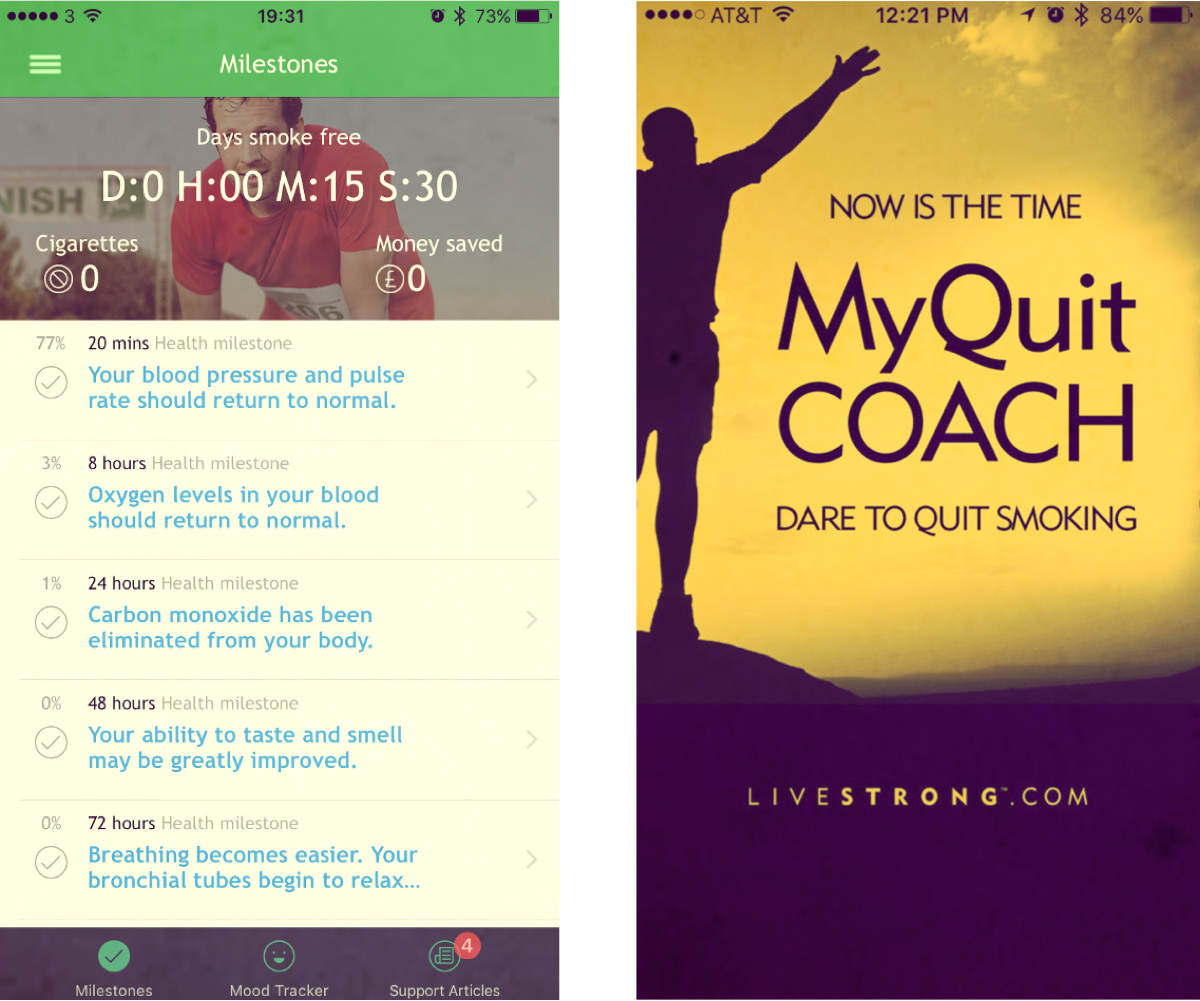
Competitor analysis
We looked at over 70 apps including the client’s own apps and programmes. Most were smoking cessation, however we also looked at other health apps that employed behavioural change methodologies like Weight Watches.
I enlisted our US team to analyse smoking cessation apps from a UX lens. Having been in regular contact with them, they understood the task at hand.
What I wanted to do was to approach these apps from the mindset of a smoker looking to quit. I was focused on the what the quit programme offered and how it would help me quit smoking. The idea was to see if we could use some of the learnings to inform our programme.
A couple of apps were based on the Transtheoretical Model (TTM), however the majority of the ones we tested weren’t based on any behavioural change methodologies and seemed to focus only on the long term goal.
Competitor analysis
We looked at over 70 apps including the client’s own apps and programmes. Most were smoking cessation, however we also looked at other health apps that employed behavioural change methodologies like Weight Watches.
I enlisted our US team to analyse smoking cessation apps from a UX lens. Having been in regular contact with them, they understood the task at hand.
What I wanted to do was to approach these apps from the mindset of a smoker looking to quit. I was focused on the what the quit programme offered and how it would help me quit smoking. The idea was to see if we could use some of the learnings to inform our programme.
A couple of apps were based on the Transtheoretical Model (TTM), however the majority of the ones we tested weren’t based on any behavioural change methodologies and seemed to focus only on the long term goal.

Personas
Personas were based on the psychological and emotional need to quit smoking; why they began smoking; why they continue to smoke; and why they were unsuccessful in previous attempts. These personas were story driven so the client could have a better understanding and create a bond with their user.

Personas
Personas were based on the psychological and emotional need to quit smoking; why they began smoking; why they continue to smoke; and why they were unsuccessful in previous attempts. These personas were story driven so the client could have a better understanding and create a bond with their user.

-05 Behavioural change
We read a lot of case studies and research papers of behavioural change techniques and smoking cessation. TTM was heavily referenced in these case studies with a great deal of success.
With the help of the Head of Health at J&J, we delved deeper into TTM and we found that during the Action stage of the theory, there was no real support for the quitter, with only focus on long term goals.
This stage was critical for a successful quit attempt.
More current behavioural change methodologies
As the research evolved, so did the quit programme and change methodologies. We explored 2 more methodologies (amongst others) against our personas and our user research to sit alongside TTM.
We looked at the Habit Loop by Charles Duhigg which details how cues lead to a routine and then reward. A cue is reguarded as the trigger in smokers terms. Some found stressful situations at work as a trigger. The routine would be to head outside for a smoke. The reward was satisfying that craving.
We also referenced Tiny Habits by BJ Fogg which focuses on adding a new tiny habit onto an existing habit until it then becomes easy to maintain and a part of everyday life.
With the backing of the J&J experts, we could tie the Habit Loop into changing how triggers were handled, and Tiny Habits into instigating change by breaking it down in many tiny changes.
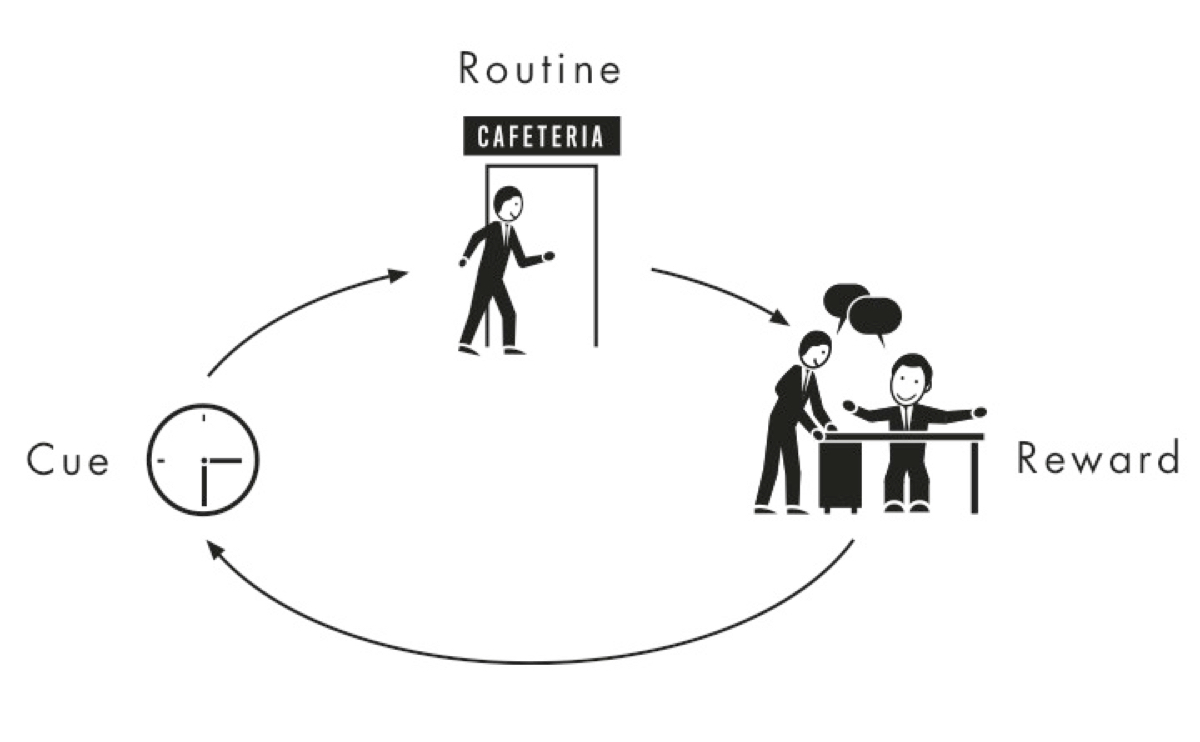
The Habit Loop
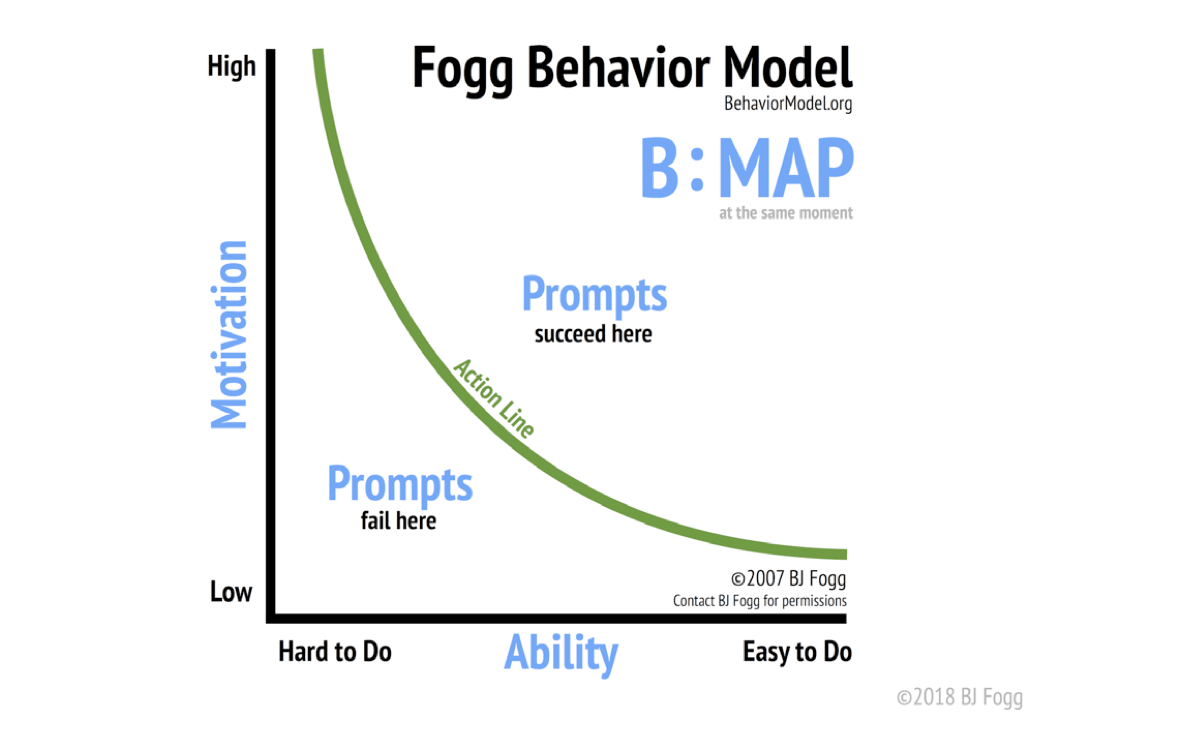
Tiny Habits
More current behavioural change methodologies
As the research evolved, so did the quit programme and change methodologies. We explored 2 more methodologies (amongst others) against our personas and our user research to sit alongside TTM.
We looked at the Habit Loop by Charles Duhigg which details how cues lead to a routine and then reward. A cue is reguarded as the trigger in smokers terms. Some found stressful situations at work as a trigger. The routine would be to head outside for a smoke. The reward was satisfying that craving.
We also referenced Tiny Habits by BJ Fogg which focuses on adding a new tiny habit onto an existing habit until it then becomes easy to maintain and a part of everyday life.
With the backing of the J&J experts, we could tie the Habit Loop into changing how triggers were handled, and Tiny Habits into instigating change by breaking it down in many tiny changes.

The Habit Loop

Tiny Habits
-06 Behavioural quit programme
We used the personas as the basis to structure the quit programme based on the behavioural change methodologies we researched – validated by the J&J experts.
We ensured that our programme would cater to quitters at different stages of the quit journey – something that was lacking from other quit programmes that focused on going cold turkey.
We broke down the programme by rewarding users frequently for major tasks and milestones during the journey. When they were craving, we provided distractions to help ease that craving.
We developed a weening programme so users used the device less the further through the journey they went before finally quitting for good.
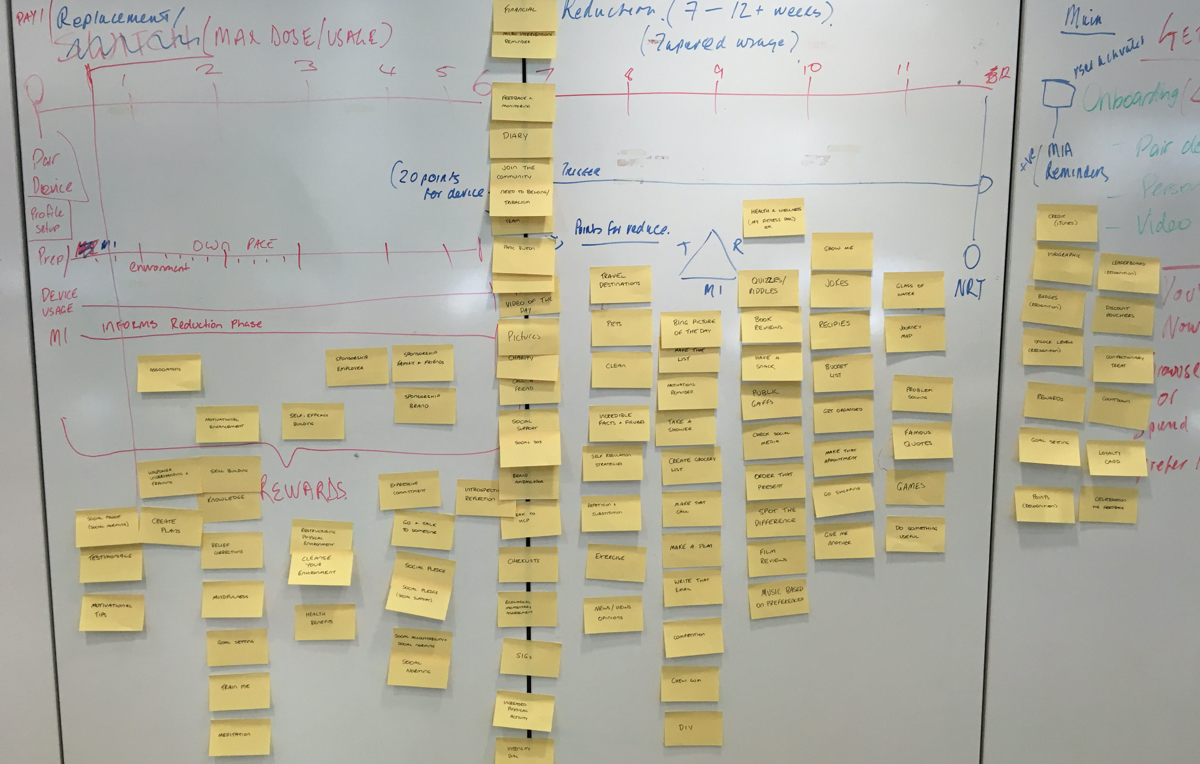
Part of the quit programme

Part of the quit programme
-07 Tying user flows to the quit programme
I demonstrated how the program would work based on a few illustrated user flows. Narrative was key to establish a bond between the quitter and our client.
In one such flow we told the story of Sebastian who had planned to go smoke free for the birth of his daughter. During an intense craving, he activates the app to view a distraction.
He’s going through distraction after distraction and they don’t seem to be working. He’s about to take a cigarette from a colleagues desk when his wife rings and asks if he’s ok. She had been notified that her husband was struggling through a crave. She sends him a photo of a baby scan to remind him why he’s quitting and eventually the craving subsides.


-08 What happened
The client was delighted with the full recommendation and the work that had gone into it.
At the time, the device was still going through the clinical trail phase. We had recommended that once it had passed the clinical trial, that the quit program be tested with the device.
This would prove difficult as clinical trials were running a lot longer than anticipated. Then the product hadn’t passed approval which killed the project.
However because they were impressed with the work, they decided to incorporate parts of the quit program to re-invent their UK app. Up until that point they had no intention of touching that app.
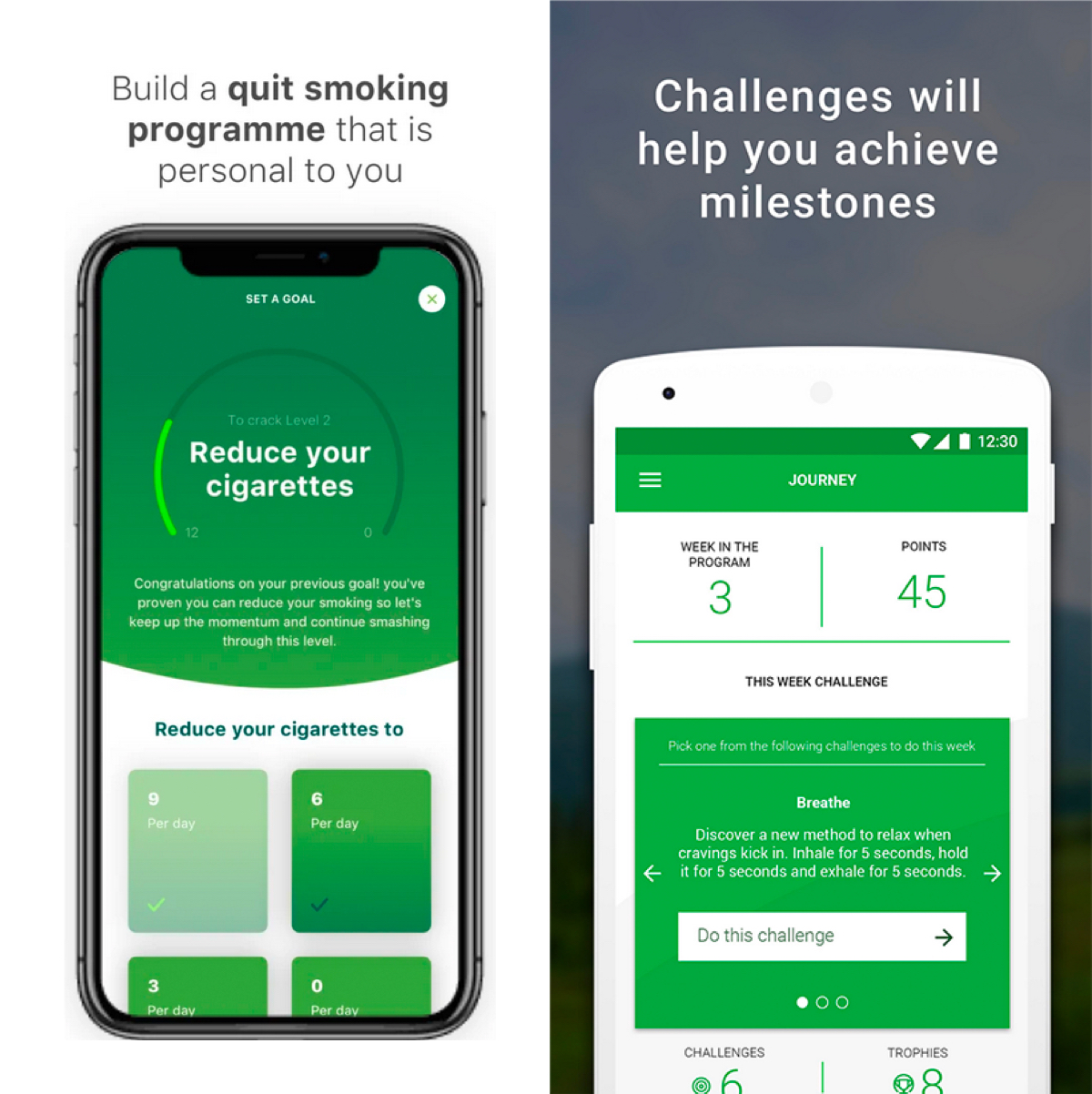
The client was delighted with the full recommendation and the work that had gone into it.
At the time, the device was still going through the clinical trail phase. We had recommended that once it had passed the clinical trial, that the quit program be tested with the device.
This would prove difficult as clinical trials were running a lot longer than anticipated. Then the product hadn’t passed approval which killed the project.
However because they were impressed with the work, they decided to incorporate parts of the quit program to re-invent their UK app. Up until that point they had no intention of touching that app.
